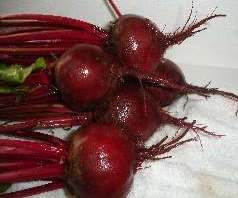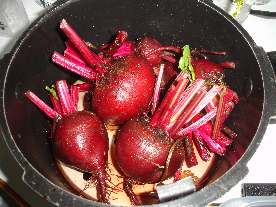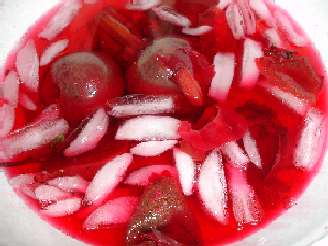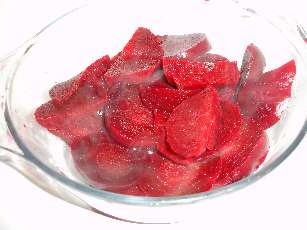
Looking for How to Freeze Beets in 2025? Scroll down this page and follow the links. And if you bring home some fruit or vegetables and want to can, freeze, make jam, salsa or pickles, see this page for simple, reliable, illustrated canning, freezing or preserving directions. There are plenty of other related resources, click on the resources dropdown above. If you are having a hard time finding canning lids, I've used these, and they're a great price & ship in 2 days.
If you have questions or feedback, please let me know! There are affiliate links on this page. Read our disclosure policy to learn more.
How to Freeze Beets
Freezing Beets
Since beets are almost exclusively used in a cooked form, which means that losing the raw texture is less important, so they do freeze fairly well. Here's how to freeze beets to store in your freezer at home. Freezing keeps beets safe to eat almost indefinitely, but the recommended maximum storage time of 12 months is best for taste and quality.
Directions
Step 1 - Selecting the beets
 The most important step! Select deep, uniformly-red, tender, young
beets. You need beets that are FRESH and crisp. Limp, old beets will make nasty tasting canned beets. Guests will probably throw them at
you.. Select firm, crisp beets. Remove and discard any soft, diseased, spotted and chewed up beets.
The most important step! Select deep, uniformly-red, tender, young
beets. You need beets that are FRESH and crisp. Limp, old beets will make nasty tasting canned beets. Guests will probably throw them at
you.. Select firm, crisp beets. Remove and discard any soft, diseased, spotted and chewed up beets.
How many beets and where to get them
You can grow your own, pick your own, or buy them at the grocery store. About 7 pounds of 2- to 21/2-inch diameter beets makes about 8 pints of beets.
Step 2 - Trim the ends and cut into smaller pieces
Just take a sharp knife and trim off beet tops, leaving an 1/2 to 1 inch of stem and roots to prevent bleeding of color.

Step 3 -Wash the beets!
I'm sure you can figure out how to scrub the beets in plain cold or lukewarm water using your hands or a vegetable brush. It's easier to wash them after you've cut off the tops.
Step 4 - Cook the beets
 Put similar sized beets (hopefully, they're ALL of a similar size so
they take the same time to cook) together with enough boiling water to cover them and cook until tender (usually for small beets 25 to 30 minutes; for
medium beets 45 to 50 minutes, in an open pot, or 10 - 15 minutes in a pressure cooker). Drain and discard the liquid.
Put similar sized beets (hopefully, they're ALL of a similar size so
they take the same time to cook) together with enough boiling water to cover them and cook until tender (usually for small beets 25 to 30 minutes; for
medium beets 45 to 50 minutes, in an open pot, or 10 - 15 minutes in a pressure cooker). Drain and discard the liquid.
Step 5 - Cool the beets
 You can pour ice over them, or just let them cool on their own.
It's just to cool them enough so you can handle them to remove the skins, stems, roots and then slice or quarter them.
You can pour ice over them, or just let them cool on their own.
It's just to cool them enough so you can handle them to remove the skins, stems, roots and then slice or quarter them.
Step 6 - Trim, peel and slice
 Trim off the roots and stems. The skins should easily slide off. Slice
the beets into 1/4-inch slices. You can leave the beets whole (if they are small, say 1 inch or less), or quarter them or slice them into 1/4-inch
slices.
Trim off the roots and stems. The skins should easily slide off. Slice
the beets into 1/4-inch slices. You can leave the beets whole (if they are small, say 1 inch or less), or quarter them or slice them into 1/4-inch
slices.
Step 7 - Package, label and freeze
Package in ziploc freezer bags, or better, in a vacuum food saver bag. Label; e.g., "Beets" and the current date. Seal and freeze.
Freezing keeps beets safe to eat almost indefinitely, but the recommended maximum storage time of 12 months is best for taste and quality. The quality of the frozen beets is maintained best in a very cold freezer (deep freezer), and one that keeps them frozen completely with no thaw cycles. Excluding any air from inside the bags which leads to freezer burn, by using vacuum-sealed bags, is also important to maintaining quality.
Vacuum Food Sealers
Koios Vacuum Food Sealers
The big name in home vacuum food sealers is "FoodSaver", but I recommend you forget them and go for Koios.
I've had several FoodSavers over the past 20 years and the Koios at right is more powerful, much quieter and easier to use.
I've been using it for about a year now, with absolutely no problems:
Other Vacuum food sealers (see this page for more information) with their vacuum sealing! Here's an example of a FoodSaver model:
FoodSaver V2840 Advanced Design
This one is the least expensive of the Food Saver models that has all the advanced features, like automatic bag detection and sealing, which makes it faster and easier to seal. And yes, you can seal and freeze foods with liquids (just freeze the unsealed bag in the freezer overnight, THEN seal it!)
- Home vacuum-packaging system vacuums, seals, and shuts off automatically
- Upright vacuum-sealing appliance with SmartSeal technology keeps food fresh longer
- Push-button operation; built-in roll storage and cutter; automatic liquid detection
- Crush-free instant seal; 2 vacuum speeds; 2 seal levels; progress lights; integrated bag opener
- Marinate and canister modes; includes 3 quart-size bags, 2 gallon-size bags, and a roll of bag material
- Measures approximately 6 by 18-8/9 by 10-2/5 inches; 1-year limited warranty
Looking for canning equipment and supplies?
Water bath canner with a jar rack
Pressure canners for gas, electric and induction stoves: Presto 23Qt or T-fal 22Qt
Canning scoop (this one is PERFECT)
Ball Blue book (most recent version)
Jars: 8oz canning jars for jams
Find Other types of farms:
Farm markets and roadside stands
Road trips and camping resources
Local Honey, apiaries, beekeepers
Consumer fraud and scams information
Home canning supplies at the best prices on the internet!
Maple Syrup Farms, sugarworks, maple syrup festivals
Environmental information and resources
Farms For Your Event for birthday parties, weddings, receptions, business meetings, retreats, etc.
Festivals - local fruit and vegetable festivals
Get the
most recent version of
the Ball Blue Book
With this Presto 23 quart pressure canner and pressure cooker, you can "can" everything, fruits, vegetables, jams, jellies, salsa, applesauce, pickles, even meats, soups, stews. Model 01781

You can make jams, jellies, can fruit, applesauce, salsa and pickles with water bath canners, like this Granite Ware 12-Piece Canner Kit, Jar Rack, Blancher, Colander and 5 piece Canning Tool Set

